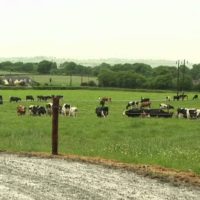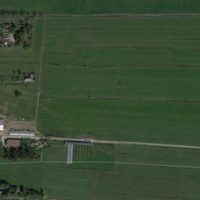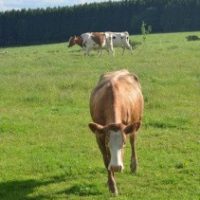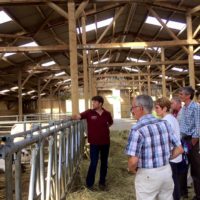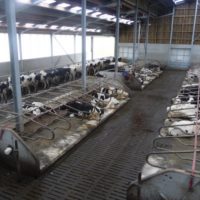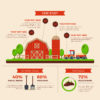Description
Background
The original farm business plan for the Greenfield Dairy Farm can be accessed at (www.greenfielddairy.ie/node/103). The plan was based on minimising capital investment on the farm while expanding cow numbers in order to maximise grass utilisation (Table 1). Cow numbers were projected to increase from 250 in Year 1 (2010) to 350 in Year 10 (2019). Milk solids yield per hectare was projected to increase from 760/ha in Year 1 (2010) to 1300kg/ha in Year 10 (2019). Cow numbers (including in calf heifers) on the farm on the first of January were 250 in Year 1 (2010), 307 in Year 2 (2011) 306 in Year 3 (2012), 346 in Year 4 (2013), 332 in Year 5 (2014) and 334 in Year 6 (2015). Milk solids/hectare was 737 kg/ha in Year 1 (2010) and 962 kg/ ha in Year 2 (2011), 983 kg/ha in Year 3 (2012), 1,090 kg/ha in Year 4 (2013), 1,079 kg/ha in Year 5 (2014) and 1,089 kg/ha in Year 6 (2015). Grass growth has increased from 12 t DM/ha in 2010 to 13.9 t DM/Ha in 2015. However, the farm is prone to drought, which was observed on the farm in 2013 with grass dry matter production running at just over 10 t/ha resulting in a significant deficit in feed supply and adding substantial cost to the overall business (feed costs in 2013 circa €103,000 versus 2014 circa €20,000).
The Greenfield Dairy Programme was created in partnership with key industry stakeholders including the Department of Agriculture, Fisheries and Food, Glanbia plc, FBD Trust, Irish Farmers Journal and AIB.
Detailed description
Grazing management
The key success driver of the Greenfield Dairy Farm is the amount and quality of grass the farm can produce. Each year since 2012 the farm has increased the amount of grass grown per hectare, with the exception of 2013. The Greenfield Dairy Farm has increased its stocking rate since the farm was set up. In 2014, an additional 8 ha was leased next to the parlour. In 2016, the average stocking rate will be around 2.80 cows/ha. Winter feed production has been variable since the start of the project.
The overall requirement of winter feed is increasing each year due to the increasing stocking rate. In 2015, 273 cows were wintered and all the culls were sold the previous autumn. By early December all the cows are dry and housed on the stand-off pad full time. The cows go to grass immediately post-calving. For the past two years the last of the cows to calves (30-40) have gone to the contract rearer for 4-6 weeks in early January; this helps to reduce pressure on winter feed and the plan is for this to continue. In 2012, 2014 and 2015 the farm was able to grow enough winter feed. In 2013, winter feed was bought in due to the poor grass growth that year. In the spring about 100-120 kg meal is fed per cow. Grass supply is generally tight towards the end of March so high quality bales are kept for the milking cows to increase rotation length. Similarly, in August when building up grass cover, cows usually get high quality bales to increase rotation length for 10 days. For the past two years the area cut for second cut silage has been reduced; when there is surplus grass; it’s cut as high quality bale silage. Winter growth is averaging 2.2kgs per day over the past 4 winters.
In terms of day to day grazing practices, cows graze pre-grazing covers of 1,500 kg DM/ha during the main grass growing season in 24 to 36 hour allocations. The post grazing height in the main grass growing season is about 4cm. The farm has never been topped and instead, paddocks are removed as bale silage when the pre-grazing paddock cover exceeds 1,600 kg DM/ha. Each year, approximately 25% of the grazing area is stopped for a large first cut of grass silage.
The Teagasc Greenfield Dairy Programme aims to provide family farmers with the skills and technologies to expand milk production and profitable grow their businesses into the future. At farm level, this will necessitate the adoption of key technologies including high quality pasture management, compact calving, higher stocking rates, high EBI replacement heifer rearing, larger herd management and low cost labour efficient farm infrastructures. At farm level this will only be a success if it is complemented with a detailed 5-year business plan.
The farm is soil sampled annually and the farm is in nitrate derogation since 2012. The farm has been allowed spread 30,000 kg N/year and we believe this is definitely reducing grass production especially on a farm that is low in soil organic matter and newly reseeded. Initially, N fertilizer was bulk spread monthly, however this has been changed to weekly spreading since 2013. Since 2013, the farm is getting two rounds of sulphur (33 kg/ha). Potash is mostly applied to grazing ground from July onwards with a small amount applied in the spring; this as a precaution against grass tetany.
Lime has been applied since 2014. The pH of the soil has decreased by -0.33 from 2012 to 2016. In 2014, the farm got 100 tonnes of lime and 200 tonnes in 2015. The 2016, soil fertility test indicates that the farm needs another 300 tonnes of lime. The plan was to spread it in the Spring of 2016; but it was too wet. The paddocks that have a lower pH on the farm also have a lower P level also. Soil testing annually gives a good indication of soil fertility on an intensive farm.
Adoption criteria
In 2013 and 2014, additional land (8ha) was leased and was reseeded with two more monoculture grasses (Kintyre, Aston Lord and Aberwolfe). Clover has been set in all paddocks and is growing actively from May onwards. Some cultivars are growing more grass and are very palatable. Others are growing high yields of grass but are not as palatable for the cows. Each year some perform better than other cultivars. This is probably to do with the fertility of the paddock. The paddocks that grow the most grass and the silage paddocks (incl. surplus bales) tend to drop in fertility very fast.
Future prospects
John uses monocultures and mixtures from varieties from the Pasture Profit Index to ensure that:
- Maximum grass output per ha is achieved on the farm
- Grass quality is excellent so paddocks can be grazed down to 4 cm throughout the grazing season
- Maximum milk solids per cow can be achieved on the farm from grass and 600 kg concentrates per year

